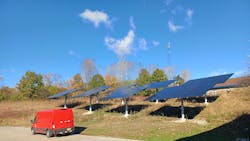Solar Photovoltaic Panels on Fire Stations
Fourteen years ago, Madison, WI, Fire Department’s Station No. 12 won awards for “environmental responsibility.” The progressive Fire Chief Debra Amesqua led the department ahead of most Midwest fire departments in the “greening” of fire stations and that effort continues today under Fire Chief Chris Carbon.
Back in 2009, the department’s 13,500-sq.-ft. building was designed to support the health and wellness of firefighters and indoor environmental quality. The station included many “green” features including rainwater cisterns, a live green roof and solar panels. Solar photovoltaic panels (PVs) on a Wisconsin fire station 14 years ago? We thought PVs were only for the citizens of California, Arizona or Florida, let alone fire stations. Wrong!
Technology has advanced and the costs have come down for PVs significantly over the years and are no longer limited to western or southern states. In fact, according to Madison Fire Department’s Assistant Chief Scott Bavery, PVs are being retrofitted to older stations, including Station 8 where they are placing their new EV engine. Bavery commented, “It would have been great to already have them in place with their increased electrical usage.” He shared that the department is currently looking at adding an EV Command car.
The 2022 Station Design Awards included several entries on the East Coast and Midwest that mentioned the use of PVs, including Alexandria, VA, Fairfax, VA, Raleigh, NC, and Clive, IA.
Renewable energy = cost savings
As expected, the popularity of PVs on the West Coast continues to increase due to municipalities’ commitments to reduced energy cost savings and environmental issues.
Jonathan Salsman, PE, Sr. Civil Engineer, City of Chula Vista’s Engineering & Capital Projects, shared, “Implementation of photovoltaics on our new City buildings, including new Fire Stations, is in keeping with the City of Chula Vista’s Climate Action Plan.” He said, “The PV system provides renewable power to the building saving on energy costs and reducing the building’s carbon footprint.”
Quest Energy Group specializes in formal LEED Certification Assistance on PVs. Greg Kinkel, principal, explained that while many people still believe that the panels can only be installed facing south, sometimes facing west will save the most on utility costs and have other advantages.
“If you are considering installing panels on your facility, several items need to be determined, including how many hours are being used and the type of roof area available,” Kinkel said, adding that an energy profile and basic energy usage of the building also needs to be established.The costs of installing PVs will vary on multiple factors. “Particularly since fire departments, law enforcement and other public safety facilities can’t take advantage of the tax benefits that most commercial businesses receive,” Kinkel said.
According to Kinkel, another factor to consider is the maintenance of PVs. “Arizona does have a monsoon season and dust storms, so maintenance is recommended twice a year and it includes checking the mountings and clearing dust that can reduce exposure for the panels.”
In the city of Tucson, Terry Gilliland, LEED, A.P., Executive Management Advisor, City Manager’s Office, explained they have panels in use on three different facilities. “Our HQ/Fire Station 1 facility has roof-mounted panels. Our training facility has multiple covered parking areas with panels and our two recently completed fire stations have panel-covered parking areas.”
Gilliand shared that the city has an agreement with a local operator who installs the panel system at zero cost. “In return, we enter into an agreement to buy the power back from them at a significantly reduced rate for a fixed price into the future,” he said. “It’s a win-win situation for both the City of Tucson as well as the vendor.”
Win-win situation
Is there a downside to having photovoltaics? Neither Salsman nor Gilliland could think of a downside of the panels in use in their cities.
Salsman commented, “I am not aware of any significant downside other that the initial capital investment. The inclusion of the PV system has long-term benefits, but it also has a significant upfront cost. So, if a project has a tight budget, the inclusion of panels may require cuts in other areas of the project.”
For the City of Tucson, Gilliland cannot think of a downside to having panels. “We benefit from lower, controlled utility expenses. We benefit from covered parking for employees and city vehicles, and we are contributing to lowering our carbon footprint.”
What should your department consider if planning to include the panels on your facility? Quest Energy’s Kinkel advises that if you are thinking about installing PVs, make sure it’s the right system for the right building. “Investigate and don’t just throw panels on every building,” he said.
“Evaluate your options and discuss with the local utility provider to find out about existing programs that may already be in place to take advantage of,” Gilliland said. “Ensure your design team for new facilities is aware of your commitment to utilizing PVs and ensure they take that into consideration with each design decision. Find a reputable contractor to partner with early in the planning stages.”
Meanwhile, Assistant Chief Bavery noted that their panels are not limited to rooftops but are installed or retrofitted on poles behind or alongside some of their stations.
“Station No. 7’s panels are on a lot next to the police station, so the panels benefit both the fire and police stations,” Bavery said.
With recent advancements in PV panels, it is worth considering for your next station and retrofitting to existing stations. If the panels work in Wisconsin, there are few limitations to where they would work.
About the Author
Janet A. Wilmoth
Special Projects Director
Janet Wilmoth grew up in a family of firefighters in a suburb of Chicago. Wilmoth, who is owner of Wilmoth Associates, worked with Fire Chief magazine for 27 years until it closed in 2013. She currently is the project director for Firehouse, overseeing the Station Design Conference.


